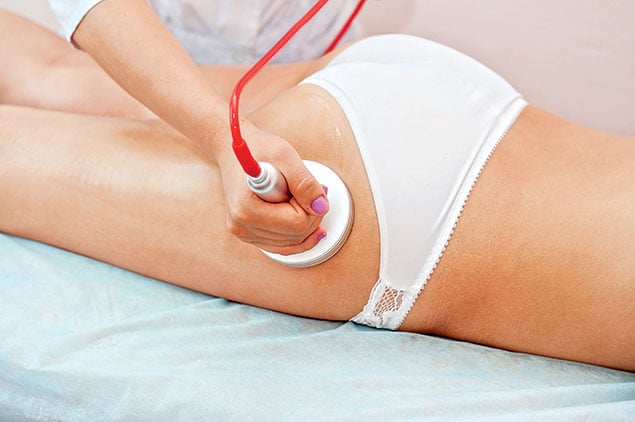Laser Therapy
How it works: A plastic surgeon makes small incisions to the cellulite-laden area. A probe placed through the incisions and under the skin emits a laser, melting fat bulges and cutting through the fibrous bands that pull on and cause dimples in the skin. New lasers, such as FDA-approved Cellulaze and CelluSmooth, require one-time treatments.
Cost: $4,000 to $7,500, depending on the size of the treated area. (Rondi Kathleen Walker, a plastic surgeon on Washingtonian’s most recent Top Doctors list, offers Cellulaze, while George Bitar, another top plastic surgeon, offers CelluSmooth.)
The verdict: Experts say that the new minimally invasive lasers are revolutionary because they require only one session and show immediate results. However, the treatments do cause bruising and swelling and sometimes require patients to wear compression clothing during the recovery period, which can be up to two weeks. Patients may need touchups once a year. Maral Kibarian Skelsey, director of dermatologic surgery at Georgetown University Medical Center, says Cellulaze is the best thing on the market but cautions that because the laser treatments are relatively new, there’s no data on long-term effects.
Anti-Cellulite Creams
How they work: Areas affected by cellulite aren’t only dimpled but also dehydrated, says Dr. Howard Murad, author of The Cellulite Solution. Applying creams or lotions that contain such active ingredients as retinol or caffeine increases blood flow to the area, temporarily reducing the appearance of cellulite.
Cost: $5 to $50 and up.
The verdict: “Don’t waste your money” on expensive lotions that advertise cellulite reduction, says Skelsey, who serves on the FDA’s general-and-plastic-surgery-devices panel. Using them is usually harmless, she adds, but “although there may be a short-term improvement [in appearance], it’s not scientifically possible that it will make an impact.”
Endermologie
How it works: A dermatologist or plastic surgeon uses a hand-held machine that suctions and kneads the patient’s skin, increasing circulation and loosening connective tissue. The treatment lasts approximately 30 minutes. It’s recommended that a patient undergo multiple sessions.
Cost: $100 and up per session.
The verdict: This type of deep-tissue massage may improve lymphatic drainage (which rids the area of waste and excess fluids) and reduce the appearance of cellulite, but only for a short time, says Dr. Melda Isaac of MI-Skin Dermatology Center: “It’s basically equivalent to fluffing up a pillow. It’ll look good in the meantime but won’t have long-lasting results.”
Radiofrequency Therapy
How it works: Radiofrequency devices apply heat to the surface of the skin, causing temporary swelling and thickening of the area, thereby smoothing the skin and minimizing the appearance of cellulite. For best results, patients are encouraged to undergo one or two sessions a week for a month or longer.
Cost: About $400 a session.
The verdict: A 2012 study published in the Journal of the European Academy of Dermatology and Venereology found that 89 percent of women who underwent radiofrequency therapy reduced their cellulite. Isaac, who offers radiofrequency in her office, says the treatment works well for mild cases. For severe cases, she says, “where you can see the shadows, peaks, and valleys,” radiofrequency alone won’t work.
Liposuction
How it works: A thin, hollow tube is inserted through small incisions and moved back and forth to loosen fat. The fat is then suctioned out using a vacuum or syringe.
Cost: An average of $2,852.
The verdict: Although patients used to think liposuction could get rid of cellulite, today the American Society of Plastic Surgeons says it’s not effective for that use. In some cases, liposuction can make the appearance of cellulite worse by creating more dimples in the skin, according to the American Academy of Dermatology.
This article appears in the December 2013 issue of Washingtonian.


















